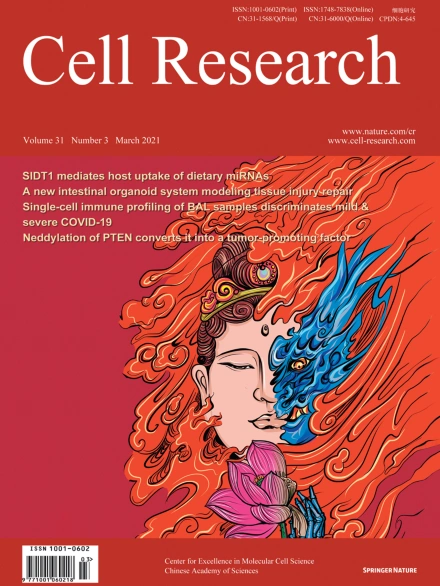
Advanced Search
Submit Manuscript
Advanced Search
Submit Manuscript
Volume 31, No 3, Mar 2021
ISSN: 1001-0602
EISSN: 1748-7838 2018
impact factor 17.848*
(Clarivate Analytics, 2019)
Volume 31 Issue 3, March 2021: 272-290
Discriminating mild from critical COVID-19 by innate and adaptive immune single-cell profiling of bronchoalveolar lavages
Els Wauters1,2 , Pierre Van Mol2,3,4 , Abhishek Dinkarnath Garg5 , Sander Jansen6 , Yannick Van Herck7 , Lore Vanderbeke8 , Ayse Bassez3,4 , Bram Boeckx3,4 , Bert Malengier-Devlies9 , Anna Timmerman3,4 , Thomas Van Brussel3,4 , Tina Van Buyten6 , Rogier Schepers3,4 , Elisabeth Heylen6 , Dieter Dauwe10 , Christophe Dooms1,2 , Jan Gunst10 , Greet Hermans10 , Philippe Meersseman11 , Dries Testelmans1,2 , Jonas Yserbyt1,2 , Sabine Tejpar12 , Walter De Wever13 , Patrick Matthys9 , CONTAGIOUS collaborators, Johan Neyts6 , Joost Wauters11 , Junbin Qian14,* , Diether Lambrechts3,4,*
1Laboratory of Respiratory Diseases and Thoracic Surgery (BREATHE), Department of Chronic Diseases and Metabolism, KU Leuven, Leuven, BelgiumHow the innate and adaptive host immune system miscommunicate to worsen COVID-19 immunopathology has not been fully elucidated. Here, we perform single-cell deep-immune profiling of bronchoalveolar lavage (BAL) samples from 5 patients with mild and 26 with critical COVID-19 in comparison to BALs from non-COVID-19 pneumonia and normal lung. We use pseudotime inference to build T-cell and monocyte-to-macrophage trajectories and model gene expression changes along them. In mild COVID-19, CD8+ resident-memory (TRM) and CD4+ T-helper-17 (TH17) cells undergo active (presumably antigen-driven) expansion towards the end of the trajectory, and are characterized by good effector functions, while in critical COVID-19 they remain more naïve. Vice versa, CD4+ T-cells with T-helper-1 characteristics (TH1-like) and CD8+ T-cells expressing exhaustion markers (TEX-like) are enriched halfway their trajectories in mild COVID-19, where they also exhibit good effector functions, while in critical COVID-19 they show evidence of inflammation-associated stress at the end of their trajectories. Monocyte-to-macrophage trajectories show that chronic hyperinflammatory monocytes are enriched in critical COVID-19, while alveolar macrophages, otherwise characterized by anti-inflammatory and antigen-presenting characteristics, are depleted. In critical COVID-19, monocytes contribute to an ATP-purinergic signaling-inflammasome footprint that could enable COVID-19 associated fibrosis and worsen disease-severity. Finally, viral RNA-tracking reveals infected lung epithelial cells, and a significant proportion of neutrophils and macrophages that are involved in viral clearance.
https://doi.org/10.1038/s41422-020-00455-9